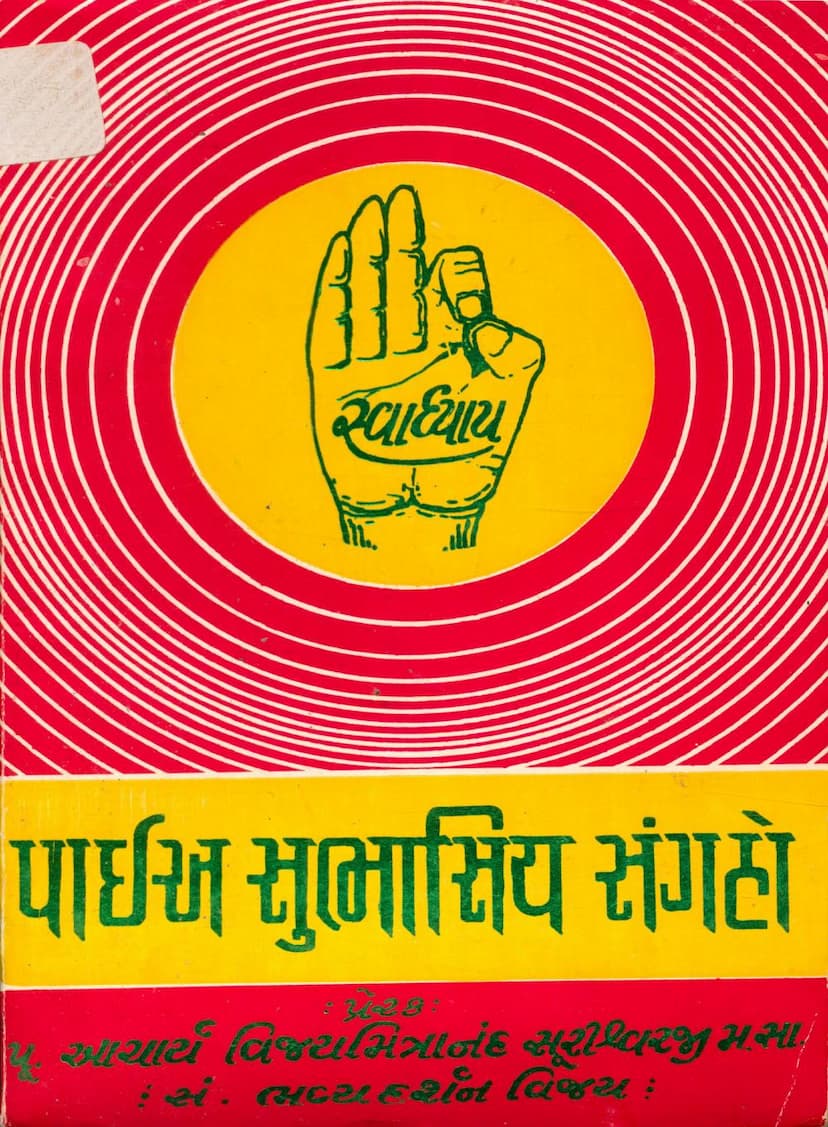Paia Subhasiya Sangaho
Added to library: September 2, 2025

Summary
This is a comprehensive summary of the Jain text "Paia Subhasiya Sangaho" (Collection of Prakrit Subhashitas) by Bhavyadarshanvijay, published by Padmavijay Ganivar Jain Granthmala. The summary is based on the provided pages, which include introductory material, a table of contents, and a significant portion of the subhashitas themselves.
Book Overview:
"Paia Subhasiya Sangaho" is a collection of "subhashitas," which are wise sayings, maxims, and aphorisms, presented in the Prakrit language. The collection aims to provide valuable spiritual and ethical guidance for Jain practitioners and all seekers of truth. The text emphasizes the importance of virtuous conduct, spiritual discipline, and understanding the true nature of reality as taught in Jainism.
Key Themes and Contents:
The book is structured around various thematic categories, each containing numerous Prakrit verses (subhashitas) that offer insights and advice. Based on the table of contents and the verses themselves, the prominent themes include:
-
Virtue and Character (Sajjano, Gunamahiima, Sheel): A significant portion of the subhashitas focuses on defining and praising virtuous qualities. These include:
- Benevolence and Helpfulness (Uvayaaro): The importance of helping others, even when it's difficult.
- Truthfulness and Sincerity (Sachcha, Ajjava): The value of speaking the truth and being straightforward.
- Humility and Modesty (Vinayatta): The virtue of being humble and not boastful.
- Patience and Forgiveness (Khanti): The strength found in enduring hardship and forgiving others.
- Integrity and Steadfastness (Thirarambha, Padivannapalane): The commitment to one's principles and promises.
- Good Conduct (Sheel): Emphasizing the importance of moral discipline and chastity.
- The Importance of Merits (Gunamahiima): Highlighting that true worth comes from virtues, not just lineage.
-
The Nature of Reality and Transience (Anichchaya, Sansarao): The text frequently reflects on the impermanent nature of worldly existence:
- Transience of Life and Possessions (Anichchaya): The collection stresses that youth, wealth, relationships, and life itself are fleeting, like a water bubble.
- The Cycle of Birth and Death (Sansarao): The subhashitas describe the continuous cycle of suffering through various life forms and the inevitability of birth, aging, illness, and death.
- The Illusory Nature of Worldly Pleasures (Visaya): Sensual pleasures are depicted as venomous, dangerous, and ultimately leading to suffering and rebirth.
-
Ethical Conduct and Morality:
- The Dangers of Vice and Evil Company (Dujjano, Khalo): The text strongly warns against associating with wicked people and highlights their negative traits like deceit, slander, and hypocrisy.
- The Value of Good Company (Sujjano): Conversely, the virtues of good company are praised.
- The Power of Dharma (Dharmo): Religion or righteous conduct is presented as the source of all good, a remedy for suffering, and the path to liberation.
- Charity and Generosity (Daan): The benefits of giving, especially to worthy recipients, are extolled.
- Non-Violence (Ahinsa): The paramount importance of protecting all life forms is emphasized.
-
Wealth and Poverty (Dhanam, Daarida): The book discusses the dual nature of wealth, its ability to elevate the virtuous but also its potential to corrupt the wicked. Poverty is shown to diminish one's perceived qualities and status.
-
Women (Mahila): A significant section is dedicated to the portrayal of women. While acknowledging their beauty and influence, the verses often highlight their fickleness, deceptive nature, and the potential for them to lead men astray, especially when driven by sensual desires. Some verses also praise virtuous women.
-
Fate and Karma (Devam, Kamma): The influence of destiny and one's past actions (karma) is acknowledged as a driving force in life, shaping one's experiences. The text asserts that actions are the cause of happiness and suffering.
-
Advice and Guidance (Upadeso): Many verses offer practical advice on how to live a righteous life, deal with challenges, and make wise decisions.
-
Miscellaneous and Concluding Sections: The book includes sections on poetry (Kavya), death (Macchu), praise of merits (Gunamahiima), harlets (Dahala), and various other topics, including specific Jain practices and principles like the Navkarmantra.
Key Message and Purpose:
The overarching message of "Paia Subhasiya Sangaho" is to guide the reader towards a life of spiritual discipline, ethical conduct, and detachment from worldly pleasures. It encourages self-reflection, the cultivation of virtues, and the unwavering pursuit of liberation (moksha) as taught by the Tirthankaras. The collection serves as a spiritual resource for daily contemplation and adherence to Jain principles.
Context of Publication:
The book is presented as the 27th publication of the "Pu. Pan. Padmavijayji Ganivar Jain Granthmala," inspired by Acharya Shrimad Vijay Mitranand Surishwarji Maharaj Saheb. It was compiled and researched by Muni raj Shri Bhavyadarshanvijayji M. and received financial support from the L.L. Zaveri Paushadhshala Trust in Surat. The publication highlights the importance of spreading Jain scripture and literature for the welfare of the Jain community and the world.